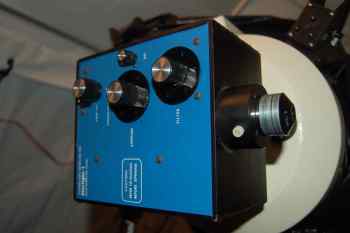For a short time in the 1980's, photoelectric photometry seemed to be taking off as a thing to do in small observatories. Articles were published discussing the attachment of the Starlight-1 to just about every small computer, even the Osbourne! This allowed automated recording of the photon counts. Many rigs were modified to allow high-speed photometry of occultations and asteroids. Ours has been modified in this fashion, with a simple computer made with a Rockwell 6502 processor, though in use it works the same as the original.
Though discontinued in 1988, sales of the units had always been steady, and in 1990, ECF Technology of Jacobus, Pennsylvania again offered the photometer, with the electronics changed slightly to account for the fact that the LeCroy MVL-100 pulse conditioner IC was no longer available. The basic model became the Starlight-10, and other models up to the Starlight-80 were offered, with this latter model being a complete setup with an 80286 computer in place of the counter. We have never, ever seen or heard of an example of these later models, however. Interest in photoelectric photometry seems to have waned in the early 1990's as CCDs attached to computers captured peoples' attention.
There are some problems with using the Starlight-1. The Fabry lens was improperly designed and does not spread the light to the proper diameter on the photocathode in the tube. If your tube has an unusually inconsistent surface, this can cause readings to vary too much if the star drifts around. Some users claimed changes of as much as 20% when the star drifted across the cathode. The lens can be replaced, if need be.
Some early units were exceptionally sensitive to interference from nearby radio stations, and it is not known if the proliferation of transmitters in recent years would make the problem even worse. There were also problems with the detents on the aperture selector becoming worn and causing the apertures to not center up properly. Another disconcerting feature is that the light from the reticle illuminating LED leaks onto the tube and saturates it when viewing through the eyepiece. A switch turns the LED off when the viewing prism is flipped up. In my opinion, the Starlight-1 head suffers from excessive complexity.
Still, our unit works just fine, and it is a great instrument to use. It is easy to use and the big readout on the counter is easy to see. The Starlight-1 has been mentioned as having been used in research in many journal articles I have read. It is a pretty nice instrument once you get the bugs worked out of your system. The tube in the Starlight-1 is sensitive enough that you can do photometry on just about any star which you can see visibly through a given telescope. I use our photometers every clear night and I generally get about .005 magnitude accuracy, even in our rather poor skies.
In comparison to the Optec units, which are currently available, I would have to rate the Optecs much higher in overall quality. The Starlight-1 is rather crudely made, while the Optec units are beautifully machined. In addition, the Optec photometers are self contained in a small package. However, the Starlight-1 does have the large readout on the counter, and it is a true photon counter. The lower priced Optec units work fine but are not true photon counters, and the Optec unit which is a counter costs about $10,000. However, in practice, I have found photometry with the lowest priced Optec SSP-3 to be just as accurate as with the Starlight-1.
I would be interested in hearing from anyone about the Starlight-1 or photometers in general. I can be reached at starrymirror@live.com . Please put "PHOTOMETER" in the title, or it may not get sorted out from all the junk mail! - GW
Copyright 2008 Starry Mirror



The
TM
Astronomy From West Virginia
THORN EMI GENCOM STARLIGHT-1 PHOTON COUNTER PHOTOMETER
Here at our little observatory, in addition to a home-made experimental 1P21 tube photometer, we also have an Optec SSP and a Thorn EMI Gencom Starlight-1 photometer. I thought it would be nice to put up a page about the Starlight-1, in case any other users might find it and want to discuss the photometer.
The Starlight-1 is a pretty rare piece of equipment. It was made in New Jersey between 1981 and 1988, and it appears that only about 200 were sold. At a price of less than $2000, it was really quite a bargain. Before the Starlight-1 came along, photometers were generally large, heavy units custom made for observatory telescopes. Production of the Starlight-1 was discontinued in 1988 when Thorn EMI moved all their electron tube operations to the UK, and it was decided that the Starlight-1 simply could not be made at a reasonable price across the ocean.

The head of the Starlight-1 is large, and we had to remove the focus knob on our 10.2 inch Cassegrain telescope in order to accomodate it. The knobs select the filter and the size of the aperture. The eyepiece is used to center the star in a reticle.